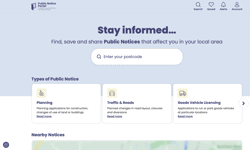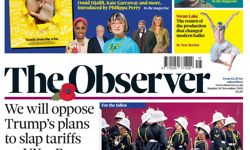
Where is national news media now on the digital transformation journey?
There has been much talk of the pandemic accelerating the pace of change, particularly in the digital arena, and Dominic Carter believes this is true of national news media. “In many ways, the pandemic - as it drove our consumers to ever-greater digital engagement with their trusted news brands - has given us permission to accelerate our digital strategy. I believe that the core building blocks of a digital future are now in place around things like subscriptions, services and the role of news brands in a digital world.”
He adds: “It’s been an unintended consequence of the pandemic that we’ve been able to accelerate our digital strategy. What was a five-year plan has become a two-year plan. It’s been incredibly inspiring to see how our teams have responded to the massive disruption by owning the potential to change. Things that seemed difficult and complicated just got done.”
At the start of the pandemic, national news media saw a massive rise in digital consumption and a drop in print sales as people stayed at home and followed the news online for the latest updates.
“Our newsrooms were already working towards a digital-first approach: they now had permission to fast-track,” says Carter. “What was also interesting was that the growth in consumption wasn’t initially matched by a corresponding growth in revenue because of advertiser blocklists. Working as an industry, we helped to educate advertisers that blocklists were a blunt tool and that’s great news for the future of news media advertising.”
In a crowded online marketplace, Carter believes it is vital for news media to make the case to advertisers for the unique value of their audiences and says this is an area where there is still room for development. He says: “We have a long-term, trusted and engaged brand relationship with our readers and that sets us apart from other digital media and the big platforms.”
Key milestones
- Building out the basics of a profitable digital news media industry around things like data, subscriptions, websites and apps.
- The development of our relationship with the platforms - which are beginning to recognise the value of quality, trusted journalism.
- In The Times and The Sunday Times, we have built out a successful subscription business, and there are huge opportunities around personalisation.
- The Sun also has incredible opportunities to further grow its known users and develop new products to serve them and deepen engagement.
- The next key milestone is around the deprecation of third-party cookies – that’s an unprecedented opportunity for a group of businesses like ours who have first party data relationships with audiences at scale.
- The other really big milestone that we’re building on now is around collaboration. The launch of The Ozone project (a shared ad network created by News UK, The Guardian and The Daily Telegraph) was about recognising that we can’t continue to fight amongst ourselves and that we need to work together to prove the value of our proposition to advertisers.
Lessons learnt
- That it’s not just about scale. Everyone built audiences like crazy a few years ago but lost sight of the fact that it’s the nature of our relationship with audiences, not just the size of them, where the value lies.
- Growth lies in building and leveraging that audience relationship, whether that’s as individual publishers or as part of a collaboration like Ozone. News brands are often regarded as ‘legacy’ media, but the real legacy is trusted engagement with our audiences. The pandemic has underlined that, as millions have turned to brands like The Times and The Sun for information, analysis and entertainment. It’s worth remembering, when the government wanted to be certain to reach the nation with its lockdown messages, it relied on news brands.
Where does national news media need to get to and how does it get there?
The key thing for news media when looking to digital transformation is to ensure a mixed economy which is financially sustainable. Carter argues: “It needs to get to the point where we can sustain and grow our mission to provide professional journalism at scale.”
He believes the way to do this is to optimise the mix of cover price, subscriptions and advertising to make sure that the economics better support the news media.
Carter says: “There are a myriad of ways we can offer more value to existing customers through greater personalisation and new product development. We are ensuring that data and insight are at the heart of our strategy and decision-making. And we are absolutely focused on growing our audience - speaking to the wide diversity of communities across the UK. That’s how we drive long term sustainable growth.”
What does the future hold?
The future is looking really positive, according to Carter. “We’ve got to a place where our biggest competition – the platforms – have acknowledged the value that we provide in a meaningful way and beyond that, the dynamic is heading in our direction,” he says.
In addition, governments everywhere are looking at online harms and at the damage that the dominance of the platforms has caused. He says: “That regulatory rebalancing is only going to open up the opportunity for a more equitable distribution of revenues across the media sector.”
National news media SWOT
STRENGTHS:
- Our relationship with our audiences. This doesn’t change with digital; the trusted relationship we have with readers has been built over tens or hundreds of years and other media simply can’t compete with that.
- Innovation. News media may have had a few false starts but I think we’re really pushing forwards on innovation, whether that’s new products and services, ways of interacting with our readers or ways of monetising our content. All fuelled by our rich data and insight.
- Collaboration. UK news media lead the world on collaboration with projects like Ozone and that’s how this industry is going to thrive.
WEAKNESSES:
Our biggest weakness to date has been in not convincing advertisers quickly enough of the unique value that our audiences can bring over other media. We need to show them the difference between the dangers of the unregulated open web and the relative safety of trusted news brands.
OPPORTUNITIES:
- Our biggest opportunity is our relationships with our consumers. They are engaged, and they trust us. They’re happy to share data with us because they know we will use it to shape a more personalised experience or create rich new products and services that meet and exceed their needs. Data and insight are the engine of our growth strategy.
- Greater collaboration. At a functional level, we need to continue to work on the ways in which our products are better sold together than individually and as a group we need to better tell the story of the value that our audiences can bring.
THREATS:
A failure to build on our track record of innovation and collaboration. The market moves quickly, and we need to stay ahead of the game.
This article is part of our special feature on The Digital Transformation Journey, originally published in April in conjunction with The Publishing Show. The feature contains the following six articles:
National news media, with Dominic Carter
Regional news media, with David Higgerson
Consumer media, with Jess Burney
B2B media, with John Barnes
Customer media, with Ann Hartland
Scientific / academic media, with Sara Sharman










